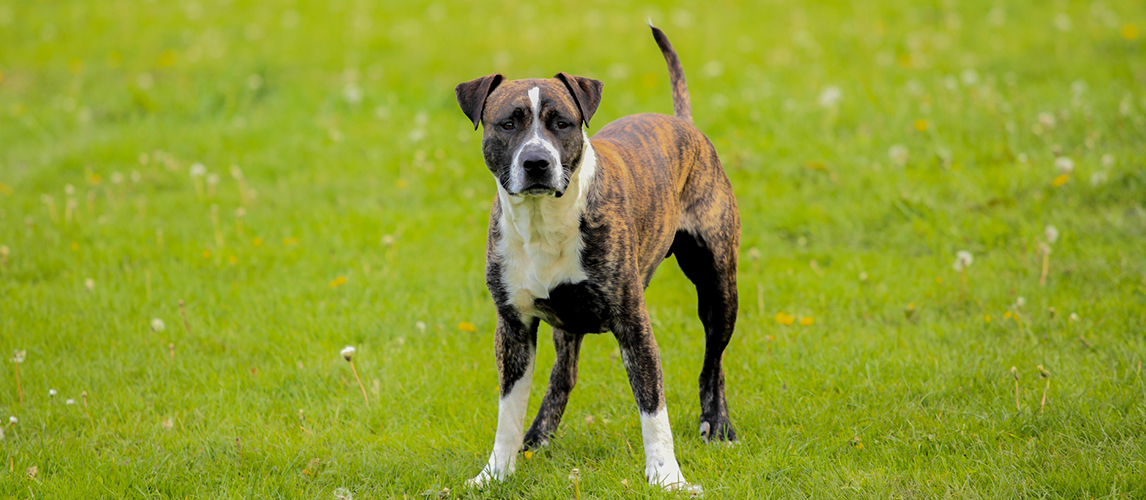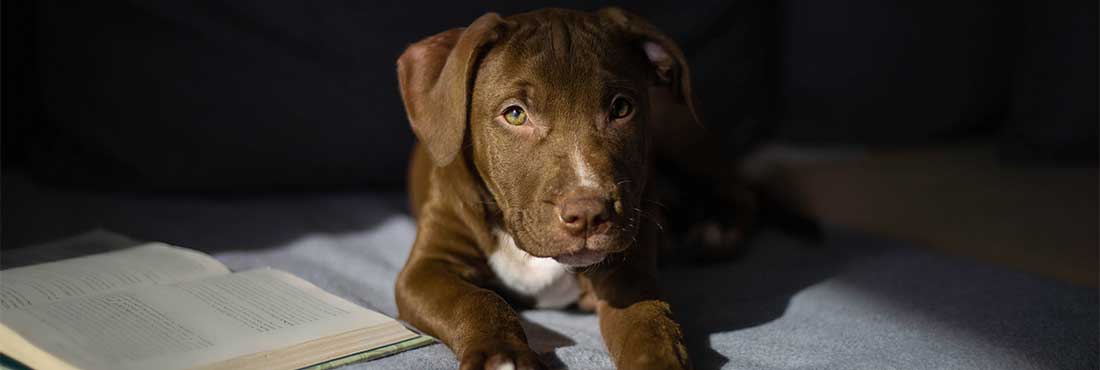The pitbull is a stunning animal that sadly often has a bad rep. But those who own or know a pittie can testify to their loyal, courageous, and lovable personalities.
Widely regarded as ‘nanny dogs’, pitbulls also make fabulous family pets. And their short coat can come in a large range of color variations, which all add to their appeal.
We explore the pitbull breed and how diverse they can be, with our informative guide to pitbull colors.
About the Pitbull
The pitbull has a long history in the States and has been a popular dog for over 150 years. The original pitbull types were bred for bull-baiting back in the 19th century. When this cruel sport was banned, the breed was taken underground and often used in dog fighting.
However, despite its aggressive and fearsome image, the breed is also known for its loving, even gentle nature, and is more of a natural protector. This led to a reputation for being an excellent nanny dog as well as a guardian.
The Four Pitbull Types
The term ‘pitbull’ is actually an umbrella name for four types of breeds descended from bulldogs and terriers.
The four pitbull types familiar to us today are:
1. American Pitbull Terrier

This pitbull type is considered a purebred dog and recognized by the United Kennel Club (UKC). American pitbull terriers have been around for more than 150 years, although have still to be officially recognized by the American Kennel Club (or AKC).
2. American Staffordshire Terrier

Also known as the ‘AmStaff’, this pitbull-type breed is formally recognized by both the AKC and the UKC. The American Staffordshire terrier has long been a popular breed, favored by three US Presidents, and is thought to be the most decorated war canine.
3. Staffordshire Bull Terrier
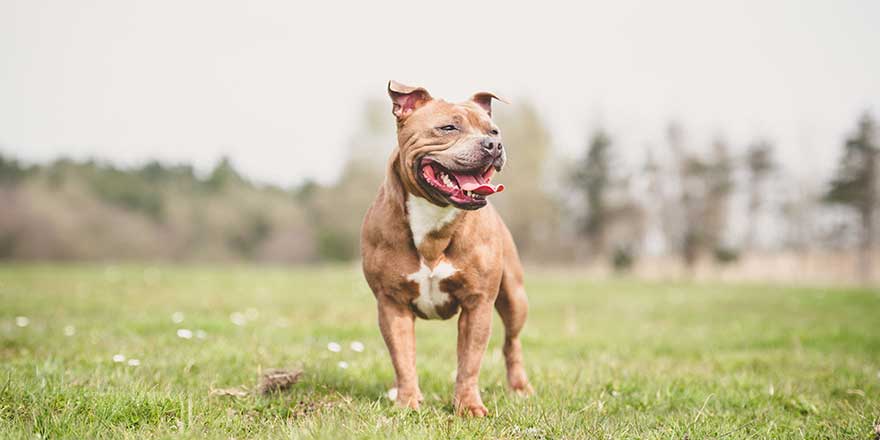
A hugely popular breed in Great Britain (named after the English region of Staffordshire), the Staffie is also the smallest of the four pitbull-type dogs. The Staffordshire bull terrier is recognized by both the AKC and the UKC.
4. American Bully

Descended from the American pitbull terrier, the American bully is the most recent pitbull type breed to be recognized in the US, with the UKC categorizing it in 2013. It is also the largest pitbull and can weigh up to 85 pounds.
Pitbull Coat Types
The typical pitbull coat is short and single-coated. It is classified as fur, not hair (dog hair, as can be found on Yorkshire terriers, for example, has a longer growth cycle). The fur in the pitbull coat is frequently shed, more so than in many other single-coated breeds.
But as their fur is short, the breed’s coat is easy to maintain and doesn’t require professional grooming or clipping.
Why do Pitbulls Have Different Colors?
As the pitbull is a category of four different breeds, then genetics mean that there will be a wide variety of pitbull colors between the different types. In fact, when looking at the official as well as unofficial colors for the pitbull breed, there are more than your average pure breed.
Some colors are recognized by at least one of the breed agencies such as AKC or UKC and are considered standard colors. But, as there are four pitbull breeds included under the pitbull umbrella, these standard colors are not consistent across the board.
The Top Colors for Pitbulls
Taking into account the standard as well as non-breed standard colors found in pitbulls, there’s a lot of choice! In fact, there are thought to be over 30 possible color variations in the four pitbull breeds.
In alphabetical order, here are the most popular colors for pitbulls.
Black

With a solid black coat, the black pitbull can also have white markings on its chest. They also have a black nose and paw pads, with warm brown eyes. The black pigment is caused by pheomelanin and is one of the most common pitbull colors across the four pitbull-type breeds.
You can also get a black mask pitbull, where there is a different base color (tan, brown, or white for example) but the dog has a full black face.
Sadly, when it comes to rehoming, the black pitbull is prone to the ‘black dog syndrome’, where dogs of other colors are more likely to be adopted. However, there is no evidence that a black pitbull is any less suitable as a family pet.
Black and Tan
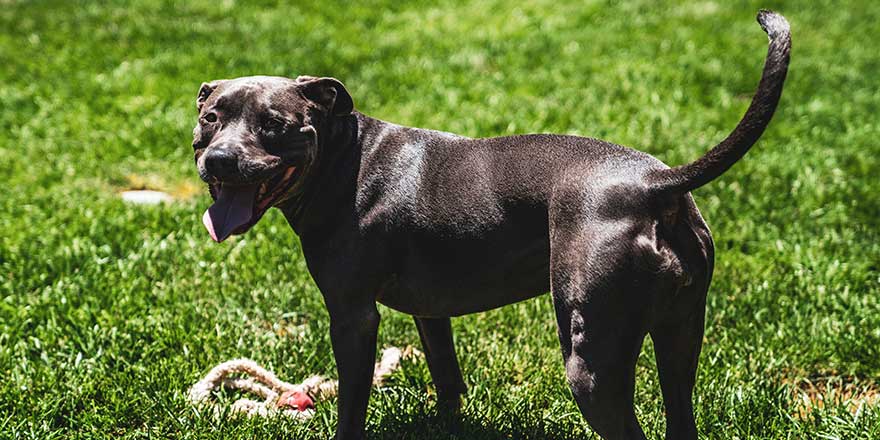
A black and tan pitbull can look like a smaller rottweiler as black and tan is a classic rottie color combo. Within the pitbull breed types, you are more likely to find true black and tan coloring, which is caused by the recessive tan-point gene, in American pitbull terriers.
With a black and tan pitbull you have a predominately black body with accents of bright tan, typically above their eyes, on the lower part of their legs, and on their chest.
Interestingly, the American Kennel Club state that black and tan across the four pitbull types are not standard and so not accepted.
Black and White
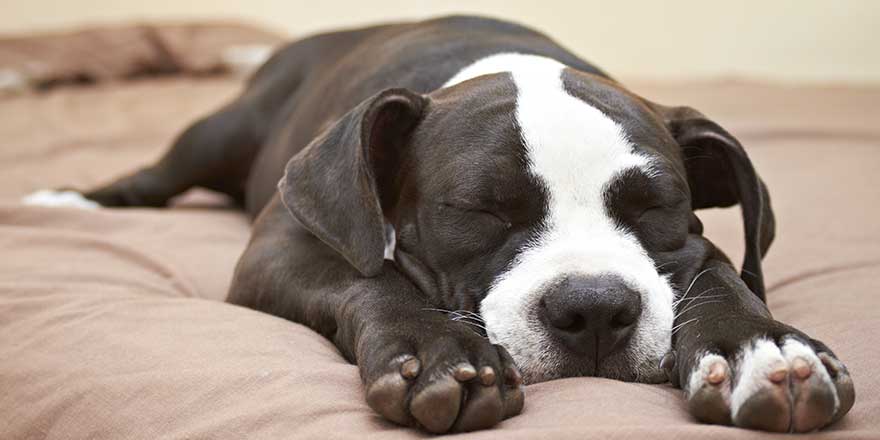
A common color for both American Staffordshire terriers and the American bully, black and white is recognized standard color for all the pitbull types.
With a black base color, broken up by large white patches, a black and white pitbull is often called a ‘moo moo’ due to its resemblance to a cow. And the ‘moo moo’ pattern was made famous by Pal the Wonder dog, a black and white pitbull that featured in the Little Rascals.
Blue

Also known as the blue nose pitbull, a blue pitbull has a stunning silver blue coat that ranges from pale gray through to a deeper, charcoal blue. They can either have a solid coat or some white markings.
Blue pitbulls also have a blue-ish nose, which is caused by a genetic dilution in the black pigment found in a dog’s skin. As well as straight-up blue nose pitbulls, you can also get a blue fawn pit and one of the most desirable pitbull colors, blue fawn brindle.
Brindle

With a pattern that looks like tiger stripes, brindle is a well-known color for numerous canine breeds, including the pitbull. In fact, one of the most famous pitbulls was a brindle known as Sergeant Stubby, who was the mascot for the 102nd Infantry Regiment during the Second World War.
The lighter base color with a darker striped effect is created by a recessive brindle allele gene which is inherited from both parents. In this instance, it is the brindle pattern that will dominate.
As well as darker stripes, a brindle pattern can also have crisscross marks which break up a dog’s coat color.
With brindle approved by the Kennel Club, there are numerous brindle color combos in pitbulls. As well as a black brindle pitbull, some of the most popular brindle colors are:
- Liver brindle pitbull
Liver brindle pitbulls will have a light grayish brown base coat, topped with stripes in rich chocolate. They may also have some white markings on their face, chest, or legs.
- Fawn brindle pitbull
With a light, creamy tan base, the fawn brindle pitbull is a beauty, with its coat set off by distinct fawn-colored stripes. You can also occasionally find another variant – the blue fawn brindle pitbull.
A rare animal, the blue fawn brindle pitbull is a head-turning combination of silver-blue coat and dark stripes.
- Blue brindle pitbull
With blue a covetable color in any of the pitbull types, a blue brindle is one of the extra special pitbull colors. That light blue base coat is scattered with darker pitbull blue stripes to make blue brindle pitbulls head-turning animals that can also have a distinctive blue nose.
- Red brindle pitbull
The base coat color of a red brindle pitbull can vary from a light pinkish cream to a darker red-brown shade, while the distinctive stripes or crisscrosses are a rich, dark red. Stunning.
Reverse Brindle

One of the most popular pitbull colors, the brindle can also surprise, thanks to a coat color known as the reverse brindle pitbull.
With a reverse brindle pitbull coat color, you get the opposite of the standard pattern. This means the base coat is a dark shade, even black, while the covering stripes are a lighter tone, such as fawn or tan.
The patterning can be very dense on some pitbulls, making them look a solid black or dark color, unless you look more closely, and you will spot the subtle lighter stripes.
Any brindle pitbull color can present as a reverse brindle. And another interesting fact is that with a reverse brindle, the dog’s nose and paw pads will match the color of its stripes.
Brown

A brown pitbull is sweet as its coat has the look of a delicious chocolate bar! Usually ranging from a rich mid to dense dark cocoa, brown pitbulls are a standard color for the breed, although they can be mistaken for a liver pitbull.
To tell the difference between the two, you need to look at the dog’s nose. Brown pitbulls as well as brown brindle pitbulls typically have a black nose, while a liver pitbull will have a liver-colored nose.
Buckskin

The color buckskin is defined by the American Dog Breeders Association as a tan with yellow tones. It can be seen as similar to the fawn color but is more yellow than red.
As a standard color for the pitbull-type breeds, a buckskin pitbull has a warm and gentle color that really sets off its pittie form.
The buckskin pitbull also has a respected heritage due to the color’s association with the renowned Crenshaw Jeep bloodline, dating back to American Pitbull Terriers in the 1970s.
As well as the light-yellow tan coat, a buckskin pitbull can also have white markings, a black face mask, and a red-toned nose.
Fawn
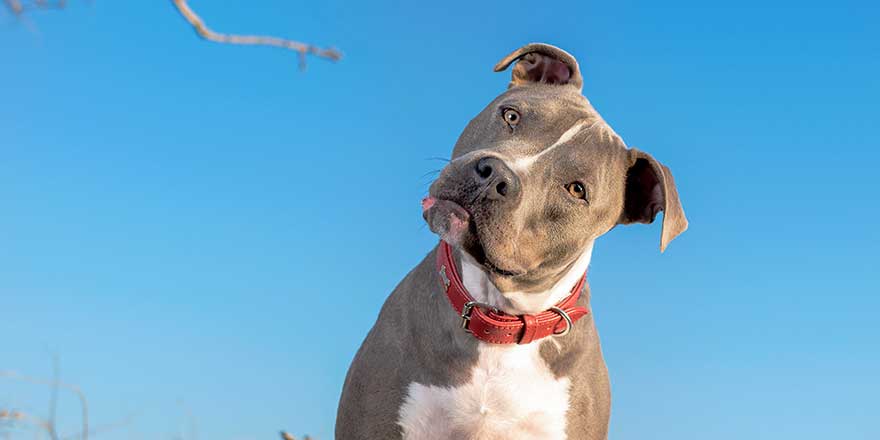
The fawn pitbull has a beige coat color that is diluted to create a shimmering yellow-tan tone. The fawn pitbull color is thought to be created by the same gene that is responsible for the sable color in some pitbulls.
Add in amber eyes and a soft beige nose, and a fawn pitbull is absolutely adorable. Most fawn pitbulls will have white markings, although many fawn pitbull puppies will be born a solid color.
- Blue Fawn
A stunning twist on the fawn color is the rare blue fawn pitbull. With a blue fawn pitbull, you get a shimmery silver-blue coat, which contrasts with the pittie’s rosy red nose.
Liver

A liver pitbull has a dark brown, almost gray tone to its coat and can often get confused with a chocolate pitbull. The best way to tell the two pitbull colors apart is to look at the nose. A liver pitbull will have a lovely matching liver-colored nose.
Despite the gorgeous, muted color, liver is not accepted by any of the breed associations as the shade is considered faulty.
Merle

Not to be confused with brindle, a merle pitbull has random patches of color over its base coat instead of uniform stripes.
Merle pitbulls can come in a variety of colors and combinations, including white, blue, tri-colored, and leopard. The top pattern is unique to the dog and can be blotches, patches, and even swirls of color that appear randomly over their coat.
- Merle Types
A blue merle will have a blue base with light to dark blue patterning on the pitbull’s coat. Meanwhile, a leopard merle has a tan base patterned with light to dark patches.
The merle trait can also come with some health issues, including problems with eyesight. This colorway is not recognized by the United Kennel Club or the American Kennel Club for the American bully or American pitbull terrier breeds.
Red
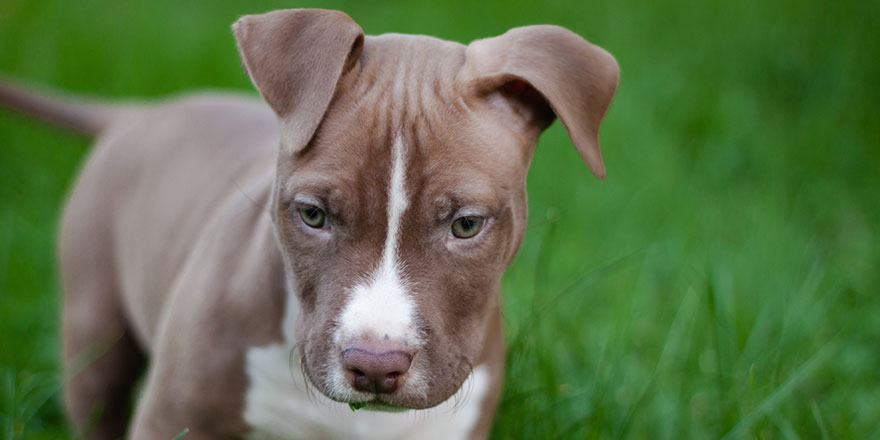
Another pitbull color that has a matching nose is the red nose pitbull. Thanks to a recessive gene, the red pitbull is a gorgeous creature, with a rich copper-red coat, amber-red eyes, and even red-colored nails.
And, as this colorway for the pitbull type is pretty rare, they are also one of the most expensive. The coat of a red nose pitbull can be either solid or contrasted with white markings.
It is thought the red nose/red coat combo originated in the American Staffordshire terrier and has worked its way through the other pitbull types. Another thing to note is that the red nose pitbull is often more muscular than other pitbulls.
Sable

A sable pitbull is a real head-turner and is quite a rare color for the breed. Sable pitbulls have a fawn or reddish base color, with matching nose and paw pads. It then has a subtle black covering which creates black tips to the fur for that almost two-tone sable look.
Sable pitbulls can also have a black mask on their face that covers their nose.
- Fawn Sable
As well as sable, you can also get fawn sable pitbulls, which are even rarer and have a yellower base color than the full sable.
Seal

The rare seal pitbull is a bit of a chameleon when it comes to its coat color. At first glance, its coat will appear sleek black. But at a different angle, or when the sunlight hits their fur, the coat of a seal pitbull takes on a lovely warm hue with a red or brown cast.
The seal pitbull color type also has a distinct feature in that there is a strip of black that runs down their spine, from head to tail.
Spotted

Pitbulls can also be spotty! Thanks to a spotting gene, you can get black and white, brown and white, and tan and white Pitbulls which all have distinct spots over their base color.
Some people confuse a spotted pitbull with a merle pitbull but look closely and the merle pattern is much more irregular. As a pitbull color, spotted is standard and recognized by the main agencies for the four pitbull-type breeds.
Tan

A tan pitbull has a lovely warm mid-shade, that’s not quite fawn but neither it is brown. More like a light beige, all tan pitbulls are not that common although you can get other variations, such as brown and tan.
Tan is an accepted pitbull color when it is a solid coat, although the United Kennel Club doesn’t recognize tan in Staffordshire bull terriers.
Tricolor
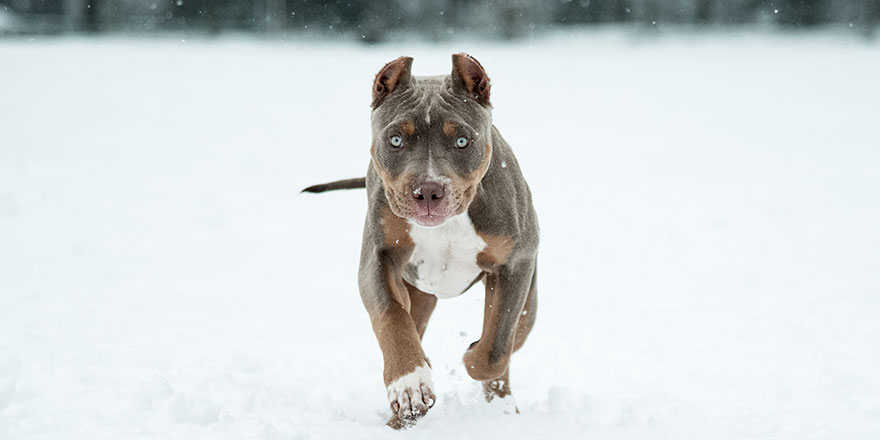
If you really want a pitbull that stands out, then you could opt for the beautiful tricolored variety. Combining three of the standard pitbull coat colors, you get a unique coat pattern that really works with the pitbull’s muscular frame.
The six main colorways for a tricolor are black, merle, lilac, chocolate, purple and blue. Many tricolors also have super-cute tan eyebrow markings, making their face extra expressive.
White
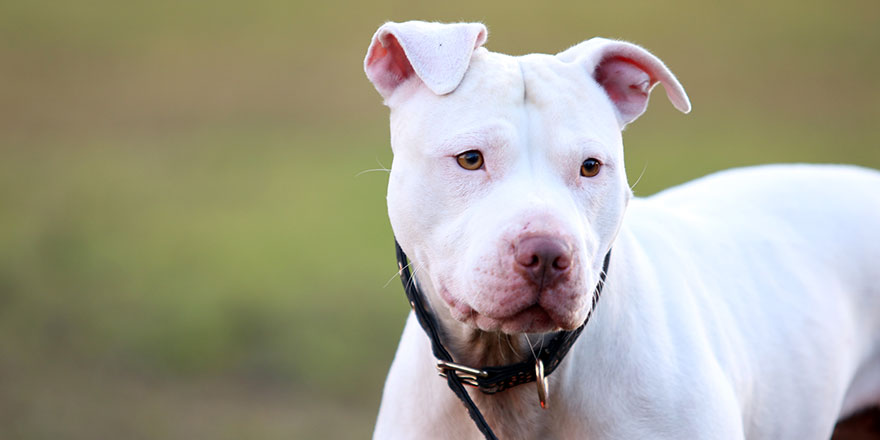
A white pitbull is fully white all over and is an accepted color in all pitbull types except the American Staffordshire terrier. However, they should not be confused with an albino pitbull.
- Albino
Albino pitbulls are white due to their inability to produce pigments in their fur and skin and are distinct from white pitbulls due to a pinkish tinge to their coat as well as their eyes. An Albino will also have a pink nose, whereas a white pitbull tends to have a black, blue, or red nose.
White pitbulls are considered as healthy as other colored pitbulls, whereas a true albino pitbull can suffer from poor eyesight, hearing, and a weakened immune system.
Can a Pitbull’s Color Affect its Health?
While there is no evidence that the color of a dog’s coat can be linked to its behavior, research has shown that it can affect its health. While not all coat colors are linked to health issues, there are certain shades that can mean a pitbull may be more susceptible to illness.
The main health issues linked to pitbull colors are:
Ears
Both merle and white pitbulls carry a gene that can lead to congenital deafness. Meanwhile one of the most common health issues affecting chocolate pitbulls is otitis externa or inflammation of the ear canal.
Blindness
The genes of merle and white pitbulls can also affect their eye health, abnormalities in the back and front of the eyes, leading to blindness. Some merle pitbulls can also be born with a condition called microphthalmia, which results in abnormally small eyes that are non-functional.
Sun sensitivity
Once again, merles and white pitbulls are affected by an increased sensitivity to the sun, due to a lack of pigment in their coat which ordinarily helps to shield their skin from UV rays.
Skin cancer
Due to this lack of pigment in their coat and skin, merle and white pitbulls are also at a higher risk of developing skin cancer. This means these pitbulls need to avoid too much sun exposure and using canine sunscreen is advised.
Skin issues
Out of all the colors, chocolate and liver pitbulls are most prone to skin diseases, especially pyo-traumatic dermatitis, which is also known as wet eczema, or hot-spot.
What is the Rarest Pitbull Color?
With at least 23 recognized or standard coat colors, many are commonly found in the four pitbull types. The most common colors for pitbulls are black and fawn (as well as their associated varieties).
Rare pitbull colors include white, merle, and blue, making pitbulls of these colors highly sought after. But it is tricolor that is considered the rarest color for a pitbull, with a blue tricolor pitbull, which also has a distinctive blue nose, the rarest of them all.
Final Thoughts
Despite their unfair reputation, pitbulls are intelligent, loving, and highly trainable dogs. Plus, their gentle nature can make them affectionate family pets. And, with such a wide choice of colors available in the breed, there’s no shortage of handsome, head-turning animals.
So, whether you choose to buy a pitbull puppy or opt to adopt, there is a pitbull color for you. Just make sure you do your homework and are aware of any health issues associated with the coat color of your new pet.
And, as their color is in no way linked to a pitbull’s personality, the color you choose can be added bonus to what will no doubt become your loyal best canine friend.
Source:
- Coat color genetics in dogs – VCA Hospitals
- Pitbull facts – Britannica


